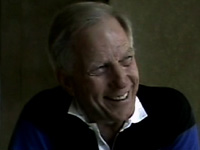|
"I think the casualty rate on a percentage basis--now, this would be wounded or killed--in my profession, which was helicopter pilot, was around 38 percent." (Video Interview,
14:46)
|
|
{
align: 'left'
}
|
Carl E. Bergman |

Carl Bergman [2005] | Vietnam War, 1961-1975
Marine Corps
163rd Marine Medium Helicopter Squadron
Captain
MN
 |
|
 |
Recruited by the Marines out of North Dakota State University in 1965, Carl Bergman
figured the Vietnam War would be over by the time he completed his aviation training.
Instead, he found himself flying enough resupply, recon, and rescue flights in country to
rack up 43 Air Medals, one for every 20 missions completed. On one occasion, trying to
evacuate a recon team heavily outnumbered by the enemy, his helicopter was shot up and
all his crew wounded; the next chopper sent in was shot down and all but one of the crew
killed. The bond forged under immensely difficult circumstances endured many years
later in biennial reunions with other pilots and vivid memories of his service.
|
|

